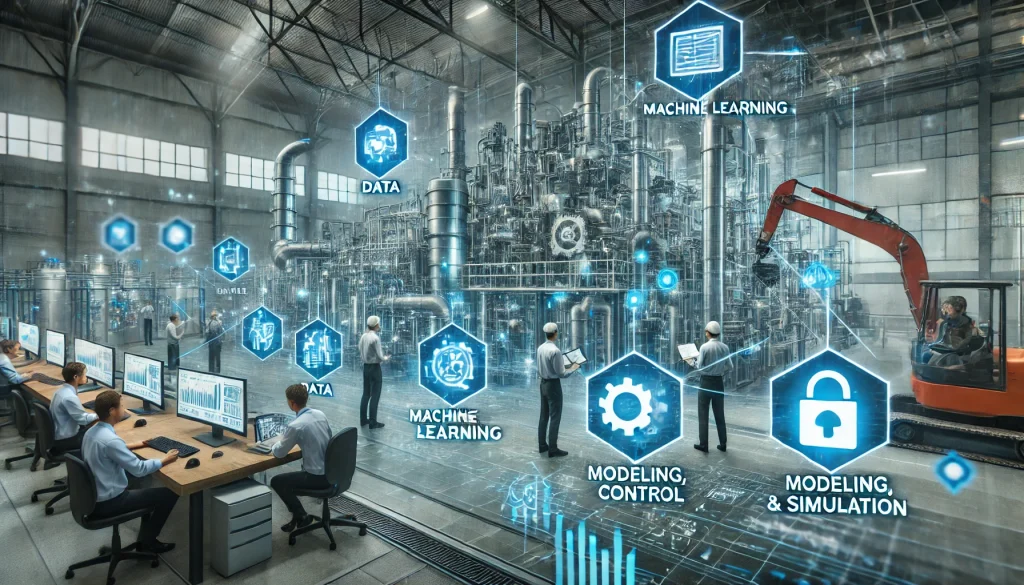Numerical and computational methods are essential tools in Process Systems Engineering (PSE), enabling engineers to model, simulate, and optimize complex industrial processes. These methods help in solving systems of integro-algebraic-differential equations, optimizing process performance, and estimating key parameters in dynamic systems. With the rise of more complex industrial systems, advanced computational techniques have become indispensable for ensuring process efficiency, safety, and scalability.
In process engineering, numerical methods facilitate the solution of multivariable systems where analytical methods often fall short. Whether it’s solving for steady-state conditions, modeling transient behaviors, or optimizing multi-step processes, these techniques play a crucial role in improving operational outcomes.
Solving Integro-Algebraic-Differential Equation Systems
One of the central challenges in process engineering is the need to solve integro-algebraic-differential equations (IADEs). These systems arise naturally in many engineering problems where processes are governed by physical laws that combine algebraic constraints with differential equations and integral terms.
From my experience, solving these equations requires a combination of numerical integration, discretization techniques, and iterative solvers. For example, in chemical reactor modeling, IADEs describe the conservation of mass, energy, and momentum. The ability to efficiently solve these systems ensures that process simulations are both accurate and reliable, allowing engineers to predict how a system will behave under different operating conditions.
Numerical techniques such as the finite difference method (FDM), finite element method (FEM), and Runge-Kutta methods are commonly used to discretize and solve these equations. Each method has its strengths depending on the problem at hand, whether it’s a time-dependent dynamic system or a spatially distributed process.
Optimization Techniques for Process Systems
Optimization is a key aspect of process engineering, as industries strive to improve efficiency, reduce costs, and minimize environmental impacts. Numerical optimization techniques help in finding the best set of operating conditions that maximize productivity while maintaining safety and sustainability standards.
Nonlinear optimization is particularly important in process systems, where processes are often governed by non-convex, highly nonlinear models. Methods such as gradient-based optimization (e.g., Newton’s method, quasi-Newton methods) and stochastic algorithms (e.g., genetic algorithms, simulated annealing) are used to explore the solution space efficiently.
In my work, optimization has been crucial for refining processes such as heat exchanger network design and reactor optimization, where multiple conflicting objectives (e.g., minimizing energy consumption while maximizing production yield) need to be balanced. The application of optimization algorithms allows for the continuous improvement of process performance through real-time adjustments based on feedback from the system.
Parameter Estimation and Identifiability in Complex Models
In any computational model, accurate parameter estimation is critical for ensuring that the model reliably predicts real-world behaviors. Parameter estimation involves using experimental or operational data to identify the values of unknown parameters in a model, such as reaction rates or mass transfer coefficients in chemical processes.
A significant challenge in parameter estimation is identifiability—the ability to uniquely determine parameter values from the available data. In some cases, even small errors in data can lead to poor parameter estimation, which negatively affects the accuracy of the model.
Through my experience in process simulation, I’ve found that sensitivity analysis plays an important role in determining which parameters have the most influence on the model’s output. This allows engineers to prioritize the most critical parameters for accurate estimation, thereby improving model fidelity.
Numerical techniques such as least-squares optimization, maximum likelihood estimation, and Bayesian inference are commonly used to estimate parameters in complex, nonlinear models. These methods rely on solving optimization problems that minimize the difference between predicted and observed data.
Experimental Planning and Sensitivity Analysis
Experimental planning and sensitivity analysis are essential components of computational methods in process engineering. These techniques allow engineers to design experiments that provide the maximum amount of information with the least amount of effort, minimizing both time and cost.
In the context of process optimization, sensitivity analysis helps to identify which variables or parameters have the greatest impact on the performance of the system. By understanding the sensitivity of the model, engineers can focus their efforts on optimizing the most critical factors.
Experimental design techniques, such as Design of Experiments (DoE), ensure that experiments are conducted efficiently and that the data collected provides robust insights into the system’s behavior. This approach has been particularly useful in my work on reactor design, where testing different operational conditions can be costly and time-consuming. By leveraging DoE, we can reduce the number of experiments required while still gaining valuable insights into how different parameters affect process outcomes.
Applications of Numerical Methods in Process Simulation
Process simulation is one of the most significant areas where numerical and computational methods are applied in process engineering. Simulation models help predict how a system will behave under various conditions, allowing for better design, control, and optimization.
Using numerical solvers to simulate processes such as distillation columns, chemical reactors, or heat exchanger networks allows engineers to evaluate multiple scenarios and optimize system performance before implementation. Simulations provide insights into operational challenges, enabling engineers to test new designs, optimize control strategies, and predict system behavior without the cost and time associated with physical experiments.
In my experience, the use of computational fluid dynamics (CFD) and dynamic simulation tools has been instrumental in modeling processes with complex geometries or those involving multiphase flows. These models require solving large systems of nonlinear equations in real time, and numerical methods provide the computational power necessary to handle these challenges efficiently.
Challenges in Computational Techniques for Process Engineering
Despite the many advantages of numerical and computational methods, there are several challenges in their application to process engineering. One of the main challenges is the computational complexity of solving large-scale systems, especially in real-time applications. As models become more detailed and incorporate more physical phenomena, the demand for computational resources increases significantly.
Another challenge is the trade-off between accuracy and computational speed. In many cases, simplifying assumptions are made to reduce the complexity of the model, but this can lead to reduced accuracy. Balancing these factors is critical to ensuring that numerical methods provide reliable results within acceptable time frames.
Furthermore, issues of numerical stability and convergence can arise when solving stiff or highly nonlinear systems. Selecting the appropriate numerical methods and carefully tuning solver parameters are essential steps in overcoming these challenges.
Future Directions in Advanced Numerical Algorithms
Looking forward, the future of numerical and computational methods in process engineering will be shaped by advances in computational power and algorithm development. The increasing availability of high-performance computing (HPC) and parallel processing will enable the solution of even more complex models in shorter times, allowing for real-time optimization and control.
Additionally, emerging techniques such as machine learning and AI-driven optimization are poised to complement traditional numerical methods by automating parts of the modeling process and providing more adaptive, data-driven solutions. Physics-informed machine learning (PIML), for example, holds promise for integrating physical laws with data-driven approaches to improve the accuracy and efficiency of simulations.
In my work, I anticipate that future computational methods will continue to push the boundaries of what can be achieved in process optimization, leading to smarter, more autonomous systems capable of responding to changes in real-time without human intervention.
Advanced Process Control (APC)
Advanced Process Control (APC) refers to a collection of techniques and technologies used to optimize…
Numerical and Computational Methods
Numerical and computational methods are essential tools in Process Systems Engineering (PSE), enabling engineers to…
Artificial Intelligence in Process Systems Engineering (PSE)
Artificial Intelligence (AI) has emerged as a transformative force in Process Systems Engineering (PSE), enabling…
Real-Time Applications and Digital Twins
Real-time applications (RTAs) are systems that process data instantaneously, delivering results or actions within predefined…
Process Systems Engineering (PSE)
Process Systems Engineering (PSE) is a multidisciplinary field that focuses on the design, modeling, analysis,…





